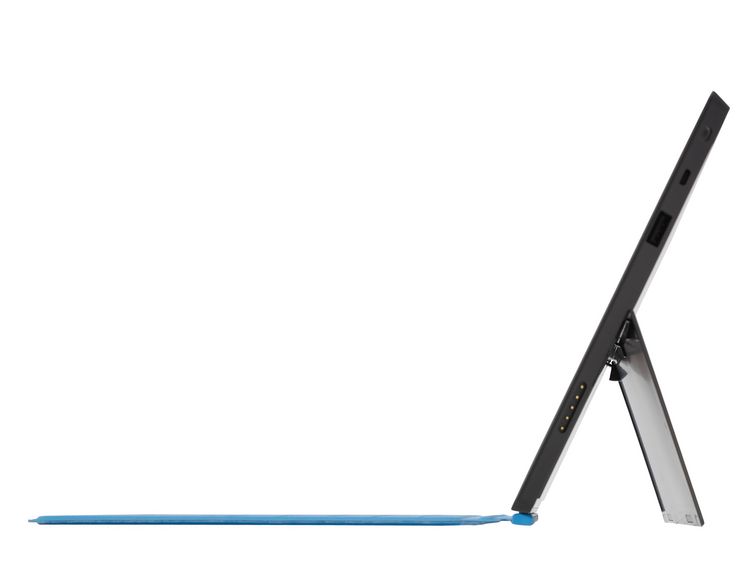Microsoft Surface RT review
Updated: A piece of engineering brilliance, but can the Surface with Windows RT satisfy the needs of a business user?
The Surface with Windows RT has undoubted limitation for a business – it won’t be replacing your laptop fleet just yet as there are niggles when it comes to using it on the move – but it’s well worth investing in one or two even now so you can see the potential for the version running Windows 8 Professional.

Design brilliance
By now, you may well have seen Microsoft's ingenious workaround to combat the inevitable problem of a tablet versus a laptop: how do you keep the screen at a position where it can be viewed whilst you type or watch a movie?
In the Surface's case, the answer is a clever little kick stand built in such a way that it sits flush with the back. This puts the screen at a 100-degree angle to the keyboard, and when working on a desk or train table we found it an excellent compromise.

We do like the kickstand - but it requires a flat surface to be at its most useful
The design gets a little annoying when used on knees say on a train without the luxury of a table. Because it's inherently flexible, when you start typing the screen bobs back and forth, and the hard lines of the kick stand do dig into your legs a little. We'd also like a little more flexibility over the angle taller people may want it to be a bit flatter than it is, for example.
But we don't want to leave the impression that it's a poorly designed. It isn't. As a whole, we found typing on the Surface a massive improvement over rival tablets, and have already typed 10,000 words on it, so Microsoft has got something right.
We're tempted to say the screen is a benefit over previous-generation laptops as well, but this comes with more caveats.
At 10.6in, you'll certainly notice the difference if you're shifting away from a 13in, 14in or 15in laptop, even if a 1,366 x 768 resolution may be similar. The reason why it might be considered a benefit is the quality of the screen itself: it's brilliantly bright and the colour accuracy is as good as you'll find on a mobile device. Photos leap from the screen.
We're also pleased to see that Microsoft hasn't jettisoned connectivity for the sake of sleekness. On the right-hand side there's a USB 2 port, which we can almost guarantee you'll find yourself using at some point.
Theoretically, pretty much any device that works with Windows 7 should be supported by the Surface, and in the majority of our tests this proved true. Only two products provide unusable: a cheap HP all-in-one and an old Fujitsu scanner (see a full list of compatible products).
A micro-HDMI port could occasionally prove useful as well, especially as Microsoft is selling adapters for VGA and full HDMI connections. Plus, you can actually extend your desktop onto a second display; not an option with the iPad.
The final piece of design ingenuity we'll salute is hidden from view, but nevertheless handy: the fact that the Surface includes two MIMO aerials, helping to ensure excellent wireless performance in our tests. As you'd expect, it supports 802.11n, while Bluetooth 4 support is a bonus.
Get the ITPro daily newsletter
Sign up today and you will receive a free copy of our Future Focus 2025 report - the leading guidance on AI, cybersecurity and other IT challenges as per 700+ senior executives
Tim Danton is editor-in-chief of PC Pro, the UK's biggest selling IT monthly magazine. He specialises in reviews of laptops, desktop PCs and monitors, and is also author of a book called The Computers That Made Britain.
You can contact Tim directly at editor@pcpro.co.uk.
-
 Enterprises face delicate balancing act with data center sustainability goals
Enterprises face delicate balancing act with data center sustainability goalsNews High energy consumption, raw material requirements, and physical space constraints are holding back data center sustainability efforts, according to new research from Seagate.
By Emma Woollacott Published
-
 Cleo attack victim list grows as Hertz confirms customer data stolen – and security experts say it won't be the last
Cleo attack victim list grows as Hertz confirms customer data stolen – and security experts say it won't be the lastNews Hertz has confirmed it suffered a data breach as a result of the Cleo zero-day vulnerability in late 2024, with the car rental giant warning that customer data was stolen.
By Ross Kelly Published
-
 Women show more team spirit when it comes to cybersecurity, yet they're still missing out on opportunities
Women show more team spirit when it comes to cybersecurity, yet they're still missing out on opportunitiesNews While they're more likely to believe that responsibility should be shared, women are less likely to get the necessary training
By Emma Woollacott Published